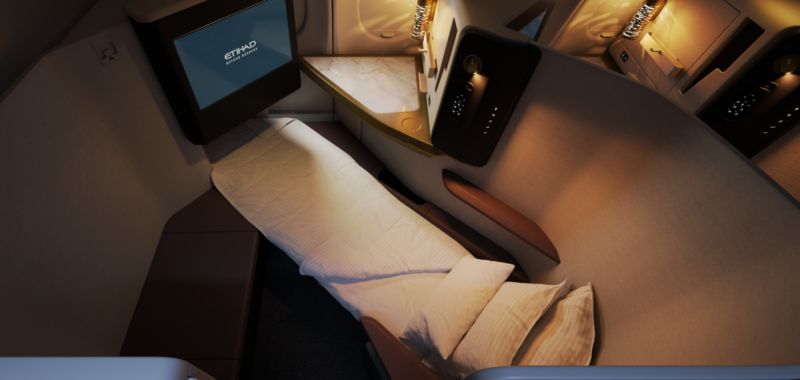In Dubai earlier this week, Etihad Airways pulled back the curtain of its newest aircraft. From the outside, the Airbus A321LR (for Long Range) looks like any other single-aisle jet. The workhorse sort thatâll get you from Barcelona to Berlin or Miami to Memphis.Â
But Etihad had a few surprises. The jetâs ability to fly longer medium-haul routes â think Abu Dhabi to Phuket or Paris â justifies investment in a more comfortable cabin.
Presenting at Arabian Travel Market, the airline previewed a three-class configuration, with a premium-heavy focus. Economy and business class were always a given, but an all-new first class product was unexpected on a relatively small plane.
Described by Etihad as the First Suite, it looks more like something found on a traditional widebody aircraft.Â
Each A321LR has just two of these ultra-luxe suites onboard â naturally located at the very front of the cabin. In many respects, the airline is following in the footsteps of JetBlue, which added an extra-spacious âMint Studioâ to its own A321LRs.

However, Etihad is positioning this as part of a distinctive first class product. Its introduction, planned for this August, goes beyond passenger experience. The aim is that first class can also be a sustainable profit center.
Speaking to Skift in his first interview after stepping off stage in Dubai, Etihad Chief Revenue and Commercial Officer, Arik De, contextualized the decision: âAirlines have become better at understanding what first [class] truly means and how to monetize it in a way that separates it from business [class], but also delivers value. That has been a journey for a lot of airlines, including us. We’ve learned a lot of lessons along the way in terms of the segmentation that we need to cater to.â
A First Class Renaissance?
Over the past two decades, many airlines have ditched the concept of first class altogether, preferring to focus on elevated business class offerings. The rise in popularity of premium economy for both corporate and higher-end leisure travelers has also blurred the lines between business class and the masses in the back.
With some very notable exceptions, it’s often considered a loss-leading trophy product; a relic of state-owned national carriers with only one eye on the bottom line.
Etihadâs De is quick to defend not the new roll-out. âFor us, first class is a product that makes economic sense. Over the last two years, it has been delivering the numbers and has been a profitable part of our business. It’s perhaps a little bit different from the Etihad of the past or other airlines. We have learned our lessons not to do vanity projects. If it doesn’t make money, it doesn’t work.â
Etihad had its wings burnt by earlier vanity projects. The national airline of the UAE first took flight in 2003. Playing catch-up with rival Emirates, it sought scale and prestige at speed. This included a series of misguided investments in now-defunct global carriers such as Air Berlin and Alitalia.
Ultimately, the strategy failed. In 2017, after another year of major losses, new management announced a wholesale restructuring plan. Rather than a global colossus, the new goal saw Etihad pivot to a mid-sized, full-service carrier, with sustainable profitability at its core.
âThere’s a reason why the commercial, and now the product team, reports to this structure that I lead,â notes De. âThe beginning of my structure is called âRevenueâ. It’s not anything else. We are very disciplined around profitability.â
Beyond the A321LR
While all eyes at ATM were on the new A321LR aircraft, the Etihad team is already looking towards its next major overhaul. Currently, the airline offers first class on just 13 planes among a fleet of almost 100. Expect this to change.
âRewind three years, we had zero aircraft with first class. Two years back, we had four A380s and five 787-9s. By the end of this year, we’re going to have five 787s, the 10 A321LRs, plus at least seven A380s. That’ll be 23 first-class enabled aircraft.
“Am I completely happy that not all of my fleet have the first class product? Of course not. But if I look at it as a journey of where we started, where we are today, I’m pretty happy with the pace at which we are going.â

De confirmed to Skift that all of the airlineâs Boeing 777s, 787-9s, and -10 Dreamliner aircraft will also have first class.
âThe question is how fast can we do the refurbishment program? We have an ambitious plan to start next year, but there is a lot of supply chain stuff that I wish I could predict. We want to [modify] two to three aircraft a month,â he said.
Despite its generous size, the Airbus A350 â introduced to the Etihad fleet in 2022 â will likely go without first class, at least for the foreseeable future.
Despite the disconnect, De says the wider vision of standardization and continuity will remain: âYes, coming off the A350, there will be an inconsistency, but it exists today. It exists at most airlines as we catch up between fleet delivery and design. But we are very confident that by the next two and a half years itâll all be standardized.â
A Refurb for the Etihad Residence?
When all of Etihadâs Boeing widebodies are equipped to the new first-class specification, De teased something else: âI think it’s leading up to the first class experience on the A380s and looking at a game-changing first class Residence Version 2.âÂ
The Residence is a widely opulent three-room private cabin, with a living room, double bedroom, and ensuite shower room. A legacy of Etihadâs flashier days, the product made a surprise return to the market when the super-jumbo A380 resumed service after the pandemic. It even sits above the nine âApartmentsâ also found on Etihadâs double-decker plane.
In 2014, it dubbed the opportunity to be the first passenger to fly in the Residence as âthe most exclusive ticket in aviation history.â
Despite multiple moving parts, and supply chain uncertainty, the take-home message from De is to expect serious investment in premium from Etihad over the coming years: âThe future for us is around the continuity of the first [class] product. We’re going to see more of that rolled out across our network, including, who knows, a refresh of the award-winning First Apartments. It’s industry-leading, but I think that it could also do with a touch-up over the next year or so.â
Read more of our interview with Arik De in the next issue of Airline Weekly.
Airlines Sector Stock Index Performance Year-to-Date
What am I looking at? The performance of airline sector stocks within the ST200. The index includes companies publicly traded across global markets including network carriers, low-cost carriers, and other related companies.
The Skift Travel 200 (ST200) combines the financial performance of nearly 200 travel companies worth more than a trillion dollars into a single number. See more airlines sector financial performance.
Read the full methodology behind the Skift Travel 200.


